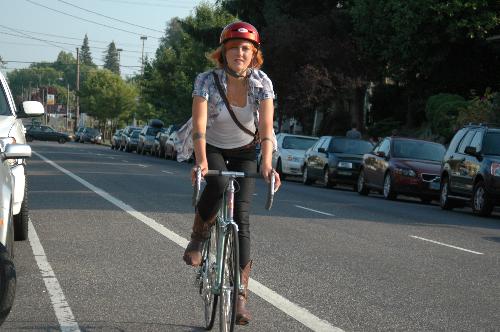Friday Quote: “Bicycling’s gender gap. It’s the economy, stupid”
“Bicycle transportation is good for a lot of things—it’s healthy, it’s green, it’s quiet, it’s fun, it builds community. It also makes financial sense, and the magnitude of bicycling’s economic impact gets far less attention than it deserves. In the Bikenomics series, Elly Blue explores the scope of that impact, from personal finance to local economies to the big picture of the national budget. In the grassroots and on a policy level, the bicycle is emerging as an effective engine of economic recovery.”
I'm a big fan of Elly Blue since her visit to Spokane last summer for the Bikestravaganza: Off The Chainring Tour. It was an energetic traveling road show of bicycle talk, movies, zines, and transportation activism and advocacy. They presented short videos and a slideshow about the success of Portland’s bike culture and infrastructure.
Lately, I've been following her series on the economics of bicycling at Grist and posting as a Friday Quote. Her latest entry is called "Bicycling's gender gap: It's the economy stupid."
That uptick in bicycling numbers you've been hearing about nationwide?
It's mostly men.
A recent paper looked at cycling demographic trends and found that, on average, nearly all the new riders on U.S. roads in the past 20 years have been men between the ages of 25 and 64.
Meanwhile, the rate of women on the roads has held steady, with 24 percent of bike trips nationwide made by women in 2009 (according to the national travel survey for that year).
There's plenty of local variation. In Minneapolis, 44 percent of riders are women. In Portland, it's 39 percent. In Chicago, on the other hand, the number of women on bikes is decreasing. In Germany, half of all riders are women. In the Netherlands, it's more than half. In Lima, Peru, it's 2 percent.
What's going on? Why don't more U.S. women ride bikes?
The two theories you hear bandied about the most are fear and fashion.
A widely cited 2009 study found that women are more likely to choose to ride on quiet residential streets, while men are more likely to choose direct routes even if they have heavier traffic. Women are an "indicator species" for cycling, this study concludes, and that cities can cajole greater women ridership by building safer-feeling bike infrastructure.
Much is also made of another concern women often express in surveys -- that cycling to work will impede our ability to conform to professional norms in clothing, makeup, and hairstyles. The response can be seen in the proliferation of the "Cycle Chic" brand, tweed rides, and the commingling of bicycling and high fashion in advertising.
There's plenty of truth in both the fear and fashion theories. But before we commit to blaming women's transportation practices on our timidity and vanity, I think it's worth looking at some other potential factors.
Like the economy.
Women are more likely than men to be poor. We still don't earn equal pay -- as recently as 2009, women made 77 cents for each dollar earned by men doing equivalent work. Other factors range from the kind of work available to women to hiring bias against pregnant women and mothers.
Read the rest of her column HERE.
